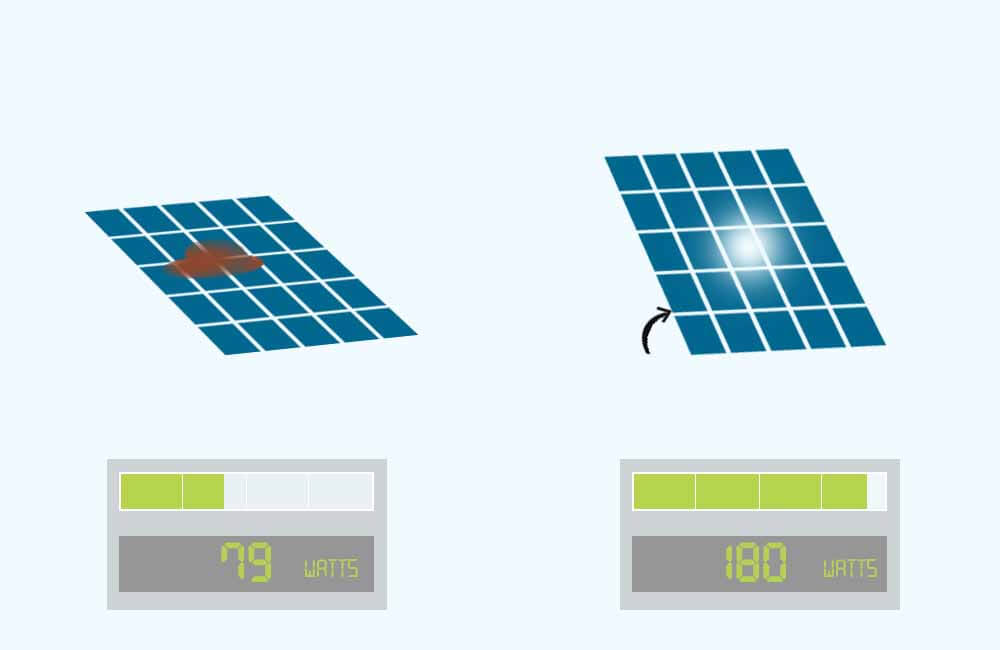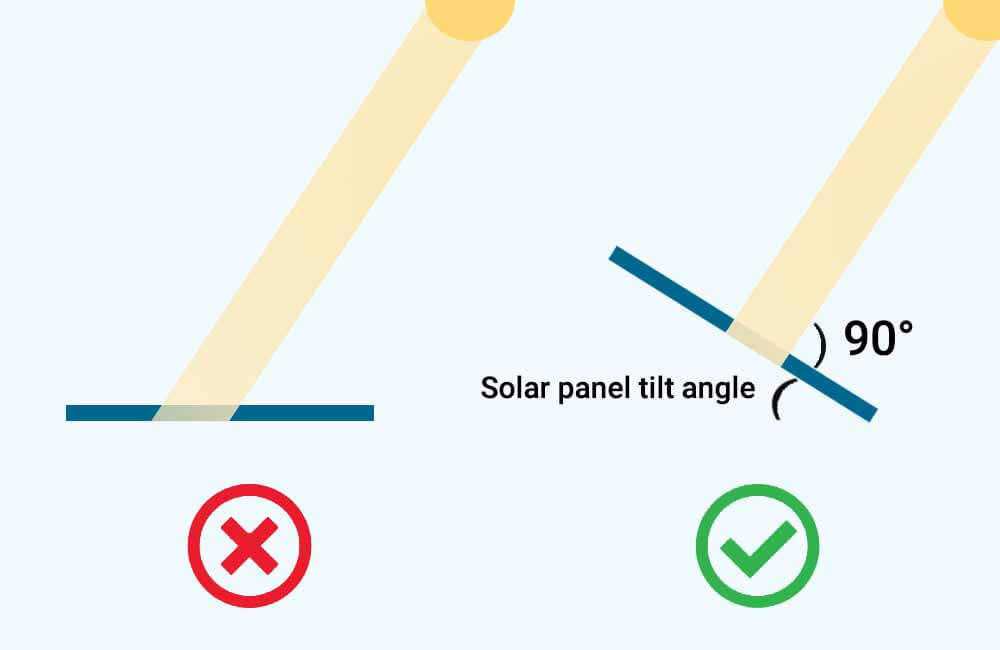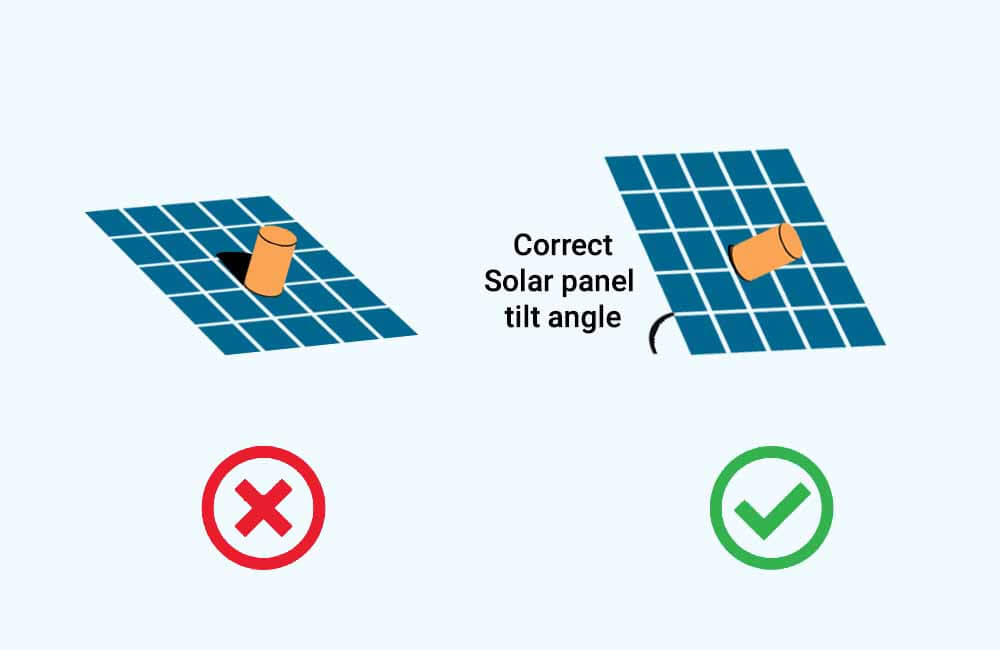
Nobody wants to buy a 200W solar panel and only get half the output power they were promised. But without a little bit of optimization, that’s probably what you’re going to get.
Losing a couple of dozen percentage points of your power output is no big deal, as solar panels don’t generally produce 100% of their wattage ratings. But if the skies are clear and your solar panel is not delivering at least 70% of its output rating, that’s a problem.
Here’s an overview how to increase solar panel output:
- Make sure there’s nothing blocking your solar panel (shade or dirt)
- Set the right tilt angle for your solar panel.
- Adjust your solar panel’s direction.
- Use an MPPT charge controller.
Here are a couple of advanced DIY solutions to increase solar panel output:
- Replacing the bypass diodes on your solar panel.
- Surrounding your solar panel with reflective material.
But before executing these steps, it wouldn’t hurt to know a little bit about how the whole thing works.
In this article, I’ll give you a few tricks along with some data that you can use to increase solar panel wattage.
How does shading or blockage affect solar panels?
A solar panel or module is typically made out of 36-72 solar cells and 3 bypass diodes, with each of the diodes wired to a group or string of cells.
When a solar panel has one or more of its solar cells blocked from sunlight, the blocked cells behave as energy consumers rather than producers; the designated bypass diode then disconnects the whole string to protect the solar panel.
Therefore, even if one solar cell on your panel is blocked, you’ll lose up to one-third of your energy production.
So make sure you don’t miss any spots next time when cleaning your solar panel, and avoid shaded areas when setting the panel.
To learn more about solar panel shading, feel free to check out this article: Do solar panels work in the shade?
How to increase solar panel output with angle and direction optimization
If all the cells on your solar panel are clean and not blocked by any dirt or leaves, the next thing you should think of is to make sure the panel is directly facing the sun.

Is it worth tilting your solar panel?
Absolutely! When sunlight hits a solar panel at 90 degrees, it performs best.
For this to happen the panel will not only have to be at the right angle of inclination but will also have to be facing the right direction.
Below we show you how you can adjust both angle and direction to get the most out of your solar panel.
How to adjust solar panel angle and direction
To make sure your solar panel is at the right tilt angle and facing the right direction, place an object on the solar panel and adjust the panel’s tilt angle until the shadow cast by the object is no longer visible.

Doing this would make sure that sunlight is hitting your solar panel at a 90-degree angle, which means your solar panel is facing the right direction with the right tilt angle.
Of course, this method is great if you have access to your solar panel and want to get those extra watts.
But keep in mind that this is not so practical as you’ll still have to change the direction and angle every hour or so.
On the other hand, if you don’t have easy access to your solar panels or just don’t fancy yourself changing things every hour, you can still optimize your panel’s output by having an idea of where the sun is.
And 2 things are important to know here:
- The right tilt for your solar panel mostly depends on the time of year (months and seasons)
- The right direction of your solar panel most depends on the time of day.
Using some Sun path diagrams, I made a couple of tables that will give you an idea on what are the best angles and directions for solar panels:
- How to set solar panel angle: Best angle for solar panels
| Month | Optimal Angle |
| January | 55°- 60° |
| February | 50° |
| March | 40°- 45° |
| April | 30°- 35° |
| May | 15°- 20° |
| Juin | 10°- 15° |
| July | 10° |
| August | 10°- 15° |
| September | 20°- 30° |
| October | 35°- 40° |
| November | 45°- 50° |
| December | 55°- 60° |
The angle here refers to the inclination degree of the solar panel relative to the ground. If your solar panel is on a tilted roof, make sure to include the tilt of the roof as well.
The reason the tilt angle is lower in the summer is that the path the sun takes is higher relative to the horizon. And with the sun being almost directly above, a lower tilt is required.
Keep in mind that these angle degrees are for when the sun is at its maximum elevation (12 pm), but still, these angles can still help you increase your solar panel output with minimum effort.
If you don’t have a protractor available, you can set the tilt angle of your solar panel by using an app, like Angle Meter for iOS or Bubble Level for Android.
Now let’s see what the best direction for solar panels is.
2. How to set solar panel direction: Best direction for solar panels
| Time | Optimal Direction |
| 5:00 – 8:00 | East |
| 8:00 – 10:00 | South-East |
| 10:00 – 14:00 | South |
| 14:00 – 16:00 | South-West |
| 16:00 – 19:00 | West |
If you don’t want to bother with changing the direction the solar panel is facing 5 times a day, direct it to the south.
Keep in mind that during the day, not only the direction can guarantee that sunlight will be perpendicular to the solar panel, but also the tilt angles.
But again, the data in these tables can help you boost your solar panel output with minimum maintenance.
Important: The information provided in the tables is based on rules of thumb, and only applies to locations in the US. The purpose of the data is to make it easier for you to set up your solar panel.
Use an MPPT charge controller to maximize power production
Solar charge controllers were initially used to protect the battery and the solar panels, but with MPPT solar charge controllers, you can protect your system and potentially produce 25% more power.
A PWM charge controller lowers the voltage from the solar panel(s) and matches it to that of the battery. While this ensures that the battery charges in a safe manner, a big portion of the power that the solar panel(s) can produce is left unclaimed.
For example, let’s say we’re using a 12V-100W solar panel to charge a 12V battery. The solar panel has the following specifications:
- Rated Power: 100W
- Rated Voltage (Vmpp): 18.6V
- Rated Current (Impp): 5.38A
The actual charging voltage of our 12V battery is around 14.4 Volts.
With a PWM charge controller, the solar panel will operate at 14.4V, given that it is under direct sunlight, the panel will produce around 5.5 Amps. So, the power it generates is:
Output Power (Watts) = 14.4V x 5.5A
Output Power (Watts) = 79.2 Watts
With this setup, 21 Watts of power are lost right off the bat.
On the other hand, an MPPT charge controller will make sure the solar panel operates at its rated voltage (18.6V) and rated Current (5.38A). This will ensure maximum power production:
Output Power (Watts) = 18.6V x 5.38A
Output Power (Watts) = 100 Watts
The MPPT then takes this output power and transforms it to a lower voltage/higher current output:
MPPT Output Current (Amps) = 100W ÷ 14.4V
MPPT Output Current (Amps) = 6.94 Amps
This way, the voltages of the solar panel and battery match, and maximum power production is ensured.
To find the best MPPT solar charge controller for your system, feel free to use our calculator here: MPPT solar charge controller calculator
Or click here to learn more about MPPTs.
Replacing bypass diodes to increase solar panel output
As mentioned above, solar panels are equipped with bypass diodes that protect their cells and ensure that the production of the whole panel is not affected by partial shading.
And just like any electronic component, the bypass diodes on a solar panel can short and become defective. This could happen because of a nearby lightning strike or other reasons.
You can confirm that one or more of the bypass diodes in the solar panel are shorted by using a voltmeter (or multimeter). Under direct sunlight, a 12V solar panel should have a 21-22V VOC (Open Circuit Voltage).
In other words, if your solar panel is under direct sunlight and the voltmeter shows a low voltage reading (14V for example), then at least one of the bypass diodes is shorted and needs to be replaced.
If you’re going to replace your solar panel’s bypass diodes to increase output, your best bet is Schottky diodes.
Can mirrors increase solar panel output?
Yes, subjecting a solar panel to extra sunlight by surrounding it with reflective materials such as aluminum foil or mirrors, can increase its output remarkably.
However, this would also concentrate heat into the solar panel, and as the panel gets hotter, its efficiency will decline, and therefore its output.
It will still produce more energy than it would’ve without reflective surroundings, but in the long term, solar panels tend to degrade when operating at high temperatures for too long.
For example, Will Prowse did this cool experiment where he surrounds a bunch of solar panels with reflective material:
Consider adding another solar panel
Finally, if none of the tricks above work, it’s probably because your solar panel is not of the best quality. A good idea would be to get a newer and more efficient solar panel.
And since solar panels are getting cheaper and cheaper every year, you could buy a 100W panel for 80-120 bucks.
If you’re intending on buying a new 200W solar panel, I recommend reading this article: What can a 200-watt solar panel run?


HELP. We are using 18 REC 420AA Pure-R, pared with microinverter IQ8PLUS-72-M-US.
We are in southern Nevada, south facing- 180* azimuth & 20* tilt, very little shade. The specification sheet is a bit confusing. The max output is 290 & peak 300, the the modules rate of 420/330, whereas my confusion the 8+ seems to be a bit under power, would it be a better investment to purchase a microinverter rated a bit larger, maybe 360 or 380, I’ve only found one video that addresses this, and my understanding is I’m limiting what my system could produce. I’m very new to this.
Hey Laura,
It is sometimes acceptable and recommended to use undersized inverters/microinverters, because the solar panels will rarely reach 100% of their rated output (420 Watts in this case), we call this solar clipping.
However, your microinverters are rated at only 290 Watts, which is only 70% of your solar panels. Since the system is in southern Nevada, and you say you have very little shade, this seems to be too undersized.
So, I would say yes, you might want to consider upgrading those microinverters.